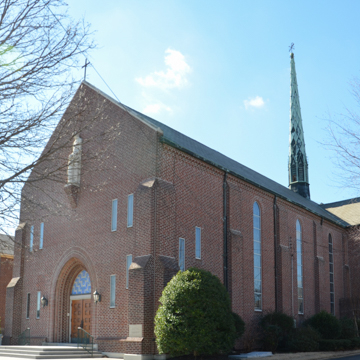St. Mary’s Catholic Church is the larger of the two churches Eames designed in Arkansas; the other is St. Mary (GE3) in Paragould. This church, a modern version of Gothic Revival, has a T-shaped plan with brick-veneered exterior walls. The church’s plain gable front has a pointed-arched entrance, four sets of paired windows, stepped buttresses at the corners, and a niche in the gable with a statue of Mary. A tall slender steeple marks the crossing of the nave, and it is clad in diamond-shaped metal shingles and adorned with Gothic-inspired arches and ornamentation. Inside, the single nave is covered by a wooden beamed ceiling. The Emil Frei Stained Glass Company created the windows, and Charles Quest painted the mural on the sanctuary wall; Eames suggested that the figures in the mural be stylized, not realistic, and designed in a manner that would relate well to the simple, austere design of the building. Subsequently, Eames’s studies at the Cranbrook Academy of Art in Michigan drew him into a broader field of design than just architecture.
You are here
St. Mary’s Catholic Church
If SAH Archipedia has been useful to you, please consider supporting it.
SAH Archipedia tells the story of the United States through its buildings, landscapes, and cities. This freely available resource empowers the public with authoritative knowledge that deepens their understanding and appreciation of the built environment. But the Society of Architectural Historians, which created SAH Archipedia with University of Virginia Press, needs your support to maintain the high-caliber research, writing, photography, cartography, editing, design, and programming that make SAH Archipedia a trusted online resource available to all who value the history of place, heritage tourism, and learning.









